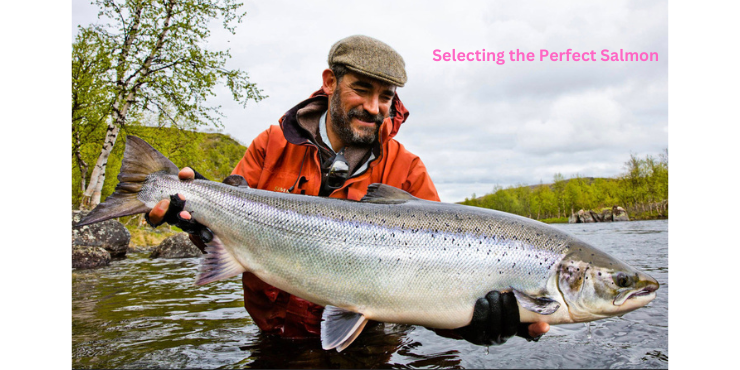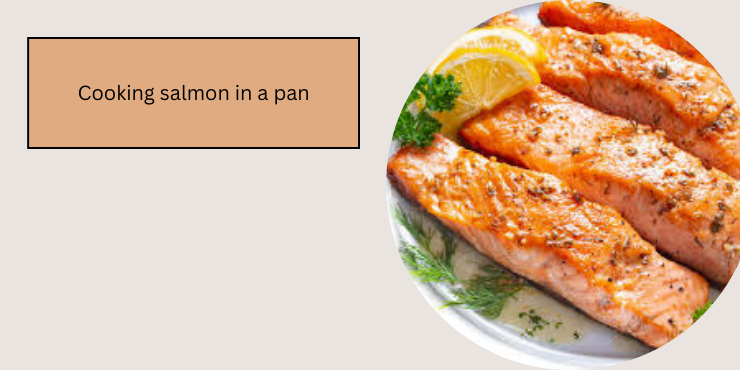Table of Contents
Cooking Salmon in a Pan ,Salmon is not only delicious but also incredibly versatile when it comes to cooking methods. One of the easiest and quickest ways to prepare this nutritious fish is by cooking it in a pan. Whether you’re a novice cook or a seasoned chef, mastering the art of cooking salmon in a pan is a skill worth acquiring. In this comprehensive guide, we’ll walk you through everything you need to know to achieve perfectly cooked salmon every time.
Choosing the Right Salmon

Before you even start cooking, it’s essential to select the right type of salmon. Look for fresh, high-quality salmon fillets with firm flesh and a vibrant color. Wild-caught salmon is often preferred for its superior flavor and nutritional value compared to farmed varieties. Additionally, consider the sustainability and environmental impact of your choice, opting for sustainably sourced salmon whenever possible.
Preparing the Salmon
Properly preparing the salmon is crucial for ensuring a delicious end result. Begin by patting the salmon fillets dry with paper towels to remove any excess moisture. This step is essential for achieving a crispy, golden-brown exterior when cooking in a pan. Season the salmon generously with salt and pepper on both sides, or get creative with your favorite herbs and spices for added flavor.
Preheating the Pan

To achieve perfectly cooked salmon with a beautiful sear, it’s important to preheat your pan properly. Choose a heavy-bottomed skillet or frying pan that can distribute heat evenly. Heat the pan over medium-high heat and add a small amount of olive oil or butter once it’s hot. Allow the oil or butter to heat up until it shimmers or foams slightly, indicating that it’s ready for the salmon.
Cooking Salmon in a Pan

Now it’s time to cook the salmon fillets. Carefully place the seasoned fillets skin-side down in the preheated pan, ensuring they’re not overcrowded. Allow the salmon to cook undisturbed for 3-4 minutes, allowing the skin to crisp up and develop a golden-brown color. Resist the temptation to move or flip the salmon too soon, as this can interfere with the searing process.
Achieving the Perfect Sear
Achieving a perfect sear on the salmon is key to locking in moisture and flavor. Once the skin side is nicely seared, gently flip the fillets using a spatula. Cook the salmon on the other side for an additional 3-4 minutes, or until it’s cooked to your desired level of doneness. Remember that salmon cooks quickly, so keep a close eye on it to prevent overcooking.
Testing for Doneness
To ensure that your salmon is cooked to perfection, you can use a fork or knife to peek into the thickest part of the fillet. The flesh should be opaque and easily flake apart with gentle pressure. Alternatively, you can use a meat thermometer to check the internal temperature, which should register between 125°F to 145°F (52°C to 63°C) for medium-rare to medium doneness.
Serving Suggestions
Once your salmon is cooked to perfection, it’s time to plate up and enjoy! Serve the salmon hot with your favorite sides and garnishes. Lemon wedges, fresh herbs, and a drizzle of balsamic glaze or honey mustard sauce can elevate the flavors of the dish. Popular accompaniments include steamed vegetables, rice, quinoa, or a crisp green salad.
Tips for Success
- Don’t overcrowd the pan: Cooking salmon in a crowded pan can cause uneven cooking and prevent proper searing.
- Use a non-stick pan: If you’re worried about the salmon sticking to the pan, use a non-stick skillet or add more oil/butter.
- Experiment with seasonings: Get creative with your seasonings to add variety and depth of flavor to your salmon dish.
- Rest before serving: Allow the cooked salmon to rest for a few minutes before serving to allow the juices to redistribute, ensuring a juicy and flavorful bite.
Conclusion
Cooking salmon in a pan is a quick, easy, and delicious way to enjoy this nutritious fish. By following the tips and techniques outlined in this guide, you’ll be able to achieve perfectly cooked salmon with a beautiful sear every time. Remember to start with high-quality salmon, properly season and preheat your pan, and cook the fillets to your desired level of doneness. With a little practice and experimentation, you’ll soon become a master at cooking salmon in a pan. Happy cooking!
FAQ,S
Q1. How do I cook salmon in a pan?
A1. To cook salmon in a pan, start by seasoning the fillets with salt, pepper, and any desired herbs or spices. Heat some oil or butter in a pan over medium-high heat. Once hot, place the salmon fillets skin-side down in the pan and cook for about 4-5 minutes. Flip the fillets carefully using a spatula and cook for an additional 3-4 minutes or until the salmon is cooked through and flakes easily with a fork.
Q2. What are some tips for cooking salmon in a pan?
A2. For best results when cooking salmon in a pan, ensure the fillets are at room temperature before cooking to ensure even cooking. Also, pat the fillets dry with paper towels to remove excess moisture, which helps achieve a crispy skin. Additionally, refrain from overcrowding the pan to allow proper heat circulation and avoid steaming the salmon.
Q3. How can I tell if the salmon is cooked through?
A3. You can tell if salmon is cooked through by checking its internal temperature with a meat thermometer. The FDA recommends cooking salmon to an internal temperature of 145°F (63°C). Alternatively, you can use a fork to gently flake the salmon—if it flakes easily and appears opaque, it’s cooked through.
Q4. What are some recommended seasonings for cooking salmon in a pan?
A4. Popular seasonings for cooking salmon in a pan include lemon pepper, garlic powder, dill, parsley, paprika, and cajun seasoning. However, feel free to experiment with your favorite herbs and spices to create a flavor profile that suits your taste preferences.
Q5. Can I use skinless salmon fillets for pan-searing?
A5. Yes, you can use skinless salmon fillets for pan-searing. However, keep in mind that salmon skin adds flavor and helps protect the flesh from overcooking. If using skinless fillets, be extra cautious when flipping them to prevent sticking and ensure even cooking.

